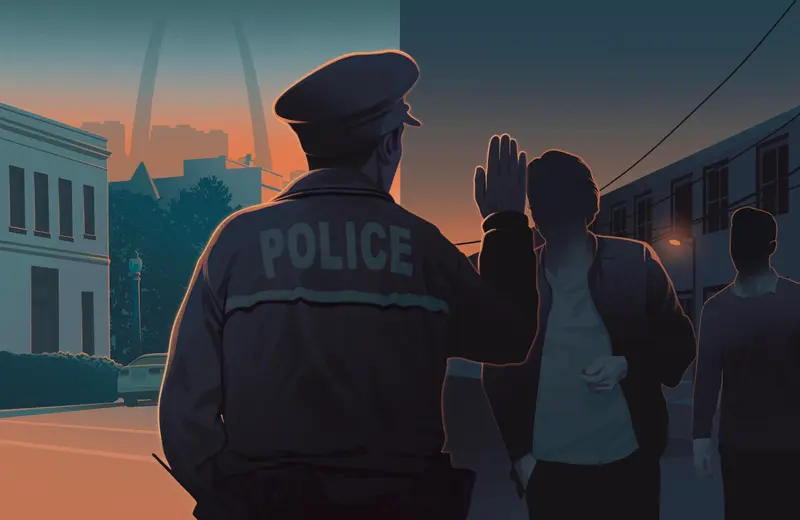Inside the Enterprise Center, the St. Louis Blues hockey team was losing a home game to the Edmonton Oilers. Outside, a man named Alvin Cooper was lying on a venting grate on a 38-degree night.
A St. Louis police sergeant asked him to move, according to an officer’s December 2018 report. Cooper refused. The sergeant and the officer pointed to signs that said “No Trespassing” and “No Panhandling.” Cooper said, “I ain’t going nowhere.” The officers tried to handcuff Cooper, one of them using “nerve pressure points on his jaw and behind his ear,” the other delivering “several knee thrusts” to Cooper’s right leg.
The officers arrested Cooper and booked him on charges of trespassing and resisting arrest. Two weeks later, a city prosecutor dropped the resisting arrest charge, while Cooper pleaded guilty to trespassing and signed an agreement offered to him by the prosecutor saying that as a condition of his probation, he would stay out of downtown St. Louis for a year.
The neighborhood order of protection, as the agreement is called, meant that Cooper could be arrested if he so much as set foot inside a 1.2-square-mile area — more than 100 city blocks — that is home to many of the organizations that provide shelter, meals and care to St. Louis’ homeless people.
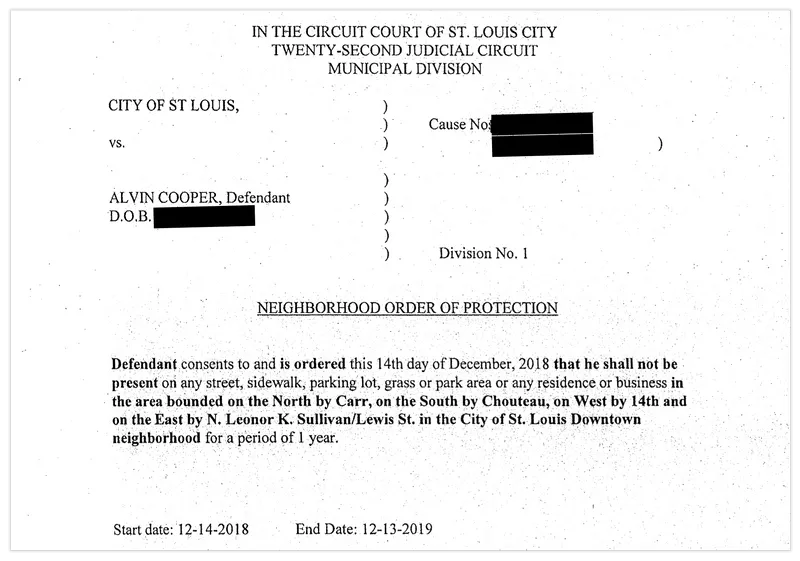
Other American cities order people to stay away from specific individuals or places, and some have set up defined areas that are off-limits to people convicted of drug or prostitution charges. But few have taken the practice to St. Louis’ extreme, particularly as a response to petty incidents, according to experts in law enforcement.
Seattle and some of its suburbs, including Everett, have blocked off certain areas of their cities as “exclusion zones” where people who have been convicted of drug or prostitution offenses can be arrested. The practice has long been criticized by civil rights advocates, but city leaders say it has helped reduce crime.
Cincinnati once barred people convicted of drug offenses from its own “exclusion zones.” But a court struck down the practice as a violation of the constitutional freedoms of association and movement, and the U.S. Supreme Court in 2003 let that ruling stand. The Chicago suburb of Elgin adopted rules in 2016 that ban people who have repeatedly caused nuisances from some sections of the city, but it has been enforced sparingly.
In St. Louis, neighborhood orders of protection affect large swaths of the city and are typically in effect for a year or two, although some orders have had expiration dates in 2099, according to records obtained by ProPublica. A person who violates an order may face a fine of up to $500 or be sentenced to as long as 90 days in jail.
Victor St. John, an assistant professor of criminology at Saint Louis University, said even limited bans may have a dire impact “in terms of individuals not being able to engage with family members or friends.”
“It’s a restriction on resources that are publicly available to everyone else,” he said, adding, “I haven’t heard of entire neighborhoods.”
Yet just how rare the practice is across the country is difficult to assess, in large part because it has not been closely tracked. University of Washington professors Katherine Beckett and Steve Herbert, who have studied Seattle’s efforts, said in their 2009 book, “Banished: The New Social Control in Urban America,” that banishment is “rarely debated publicly” and that cities’ tactics are “largely deployed without much fanfare.”
“I think part of the problem is that these legal tools are very much under the radar,” Beckett said.

When neighborhood orders of protection are employed in St. Louis, critics say that they are too often used against people with mental health issues or who may be homeless, and that banishing an individual from a large section of the city may violate their civil rights. They say the orders fail to address the underlying problems contributing to their behavior.
Instead, they simply move problems from one part of the city to another.
The ACLU of Missouri said that it had explored a lawsuit to challenge the practice a decade ago but eventually did not because the organization did not have enough information and did not have consistent contact with a potential plaintiff.
“City courts violate the constitutional rights of Missourians when they issue broad, arbitrary banishment orders untied to any legitimate governmental purpose,” the group said in a statement. “The fact that such orders are used against people who have committed harmless, petty crimes only makes plain that the orders are about inconveniencing the vulnerable, and not about public safety.”
Some people have been barred from multiple neighborhoods. Some have been arrested for violating their bans multiple times within a few days.
“It reeks of redlining,” said Mary Fox, the longtime lead public defender in St. Louis who now heads the state’s public defender system. “It reeks of everything that happened before the Civil Rights Act went through — just allowing them to keep certain people out of their neighborhoods.”
Neighborhood orders of protection are another way policing in St. Louis is employed on behalf of the wealthy and against those most vulnerable. A ProPublica investigation showed how residents of affluent city neighborhoods hire private policing companies to patrol public spaces and protect their homes and busineses, creating dramatic disparities in how local law enforcement is provided.
Private policing and neighborhood orders of protection often go hand in hand, with private police officers doing much of the work to enforce the orders, according to emails obtained by ProPublica.
The city’s Municipal Court paused issuing neighborhood orders of protection at the start of the pandemic — not because of any policy change but because the process requires the defendant to appear in court and city courts are closed to in-person proceedings.
But police have issued citations for violations of the orders as recently as July 2021, records show. Some defendants also face active court cases for alleged violations. Moreover, a city ordinance authorizing the orders remains in effect, and St. Louis police are under orders to collect evidence that can help prosecutors pursue orders of protection.
St. Louis Municipal Administrative Judge Newton McCoy said in an email that defendants may be subject to neighborhood orders of protection “on a case by case basis” as a condition of probation “if they repeatedly commit offenses in certain neighborhoods.” He said court officials are “working to determine next steps for when all in-person municipal court hearings will resume.”
The banishments require the consent of the defendant, but some lawyers question whether defendants really have any choice but to sign. In one instance, a man was arrested for trespassing while gathering on a city sidewalk with friends across the street from a downtown homeless shelter. He agreed to stay out of downtown but was subsequently arrested for a violation and served three months in jail, a case highlighted by the St. Louis Post-Dispatch.
“I don’t think the actual terms of the neighborhood order of protection were clear to my client,” said Maureen Hanlon, an attorney for the public-interest law group ArchCity Defenders. “It states that he consented to it, but he was unrepresented at the time.” She entered the case after his incarceration for violating the order, “which, on paper, he agreed to, but in reality, I really question whether or not someone can agree to an order like that without counsel.”
ProPublica was not able to determine how many neighborhood orders of protection have been issued over the past two decades. Court cases are typically sealed after the successful completion of probation. It was also unclear if any remained in effect.
Megan Green, who on Nov. 8 was elected president of the city’s Board of Aldermen and is the city’s second-highest ranking official, said she has long heard from advocates for the homeless who say the orders make it difficult for the city’s most vulnerable people to receive meals or other services.
Green said she wants to study the use of neighborhood orders of protection to “understand the implications. And if we need to take a look at a revision, I think, potentially do that.”
“If you are banning somebody from downtown from the area where services are, that makes it that much harder to address the needs,” Green added. She said she also found it problematic that “if you’re just banning somebody from a certain area, and never addressing the behavior, chances are that behavior just moves to another block or another neighborhood.
“So I’m not sure how effective something like this is at achieving what folks are going for, either.”
Neighborhood leaders and police officials have defended neighborhood orders of protection as a tool for residents and businesses to make their streets safer by sending a message to criminals that they are not welcome.
St. Louis police Sgt. Charles Wall said the department merely enforces the orders once they’re issued.
Jim Whyte, who manages a private policing initiative in the city’s upscale Central West End, said neighborhood orders of protection are “used all over the city to kind of address these very problematic people.”
Whyte said that the orders were sometimes difficult to enforce. “If the person was involved in panhandling or a crime incident, I’d call the prosecutor and say, ‘Hey, this guy was down here Thursday violating the order.’” Whyte said that the prosecutor would ask if there was an arrest and he would say “like, ‘No, there weren’t any police around.’”
In those cases, Whyte said, prosecutors would not support charging the person with a violation.
Cooper could not be reached for comment. His mother, Karen Johnson, said her son, now 39, has suffered from schizophrenia since graduating from high school. His use of prescription medication, she said, led to reliance on street drugs and a life that spiraled into homelessness. During his ban from downtown, he moved out of the city and stayed with a family member in suburban Cool Valley. The court’s action to ban her son from downtown was “wrong,” his mother said. “That’s where he was getting a lot of help — the downtown area.”
This fall, she said, he was shot and wounded in an assault while he was living in a hotel.
The impetus for neighborhood orders of protection is murky. The St. Louis Board of Aldermen in 2003 unanimously passed the ordinance laying out penalties for violating orders, but it’s not clear if they existed before. Three of the bill’s four living sponsors — Jay Ozier, Dionne Flowers and James Shrewsbury — said they do not remember what prompted the measure. The fourth, Craig Schmid, could not be reached. None remain on the board.
“Particularly if you’re talking about it in terms of panhandling or something like that, I don’t see how I could have been in favor of it,” said Ozier, who served from 2002 to 2003.
The language in the ordinance suggests it was aimed at drug offenders. “Whereas, the illegal distribution, possession, sale and manufacture of controlled substances continues to plague our neighborhoods,” it reads. But in practice, the police in St. Louis have used the orders of protection more broadly.
To obtain an order, a representative for a neighborhood must document that a person who has been arrested has repeatedly caused trouble there. A prosecutor can use this statement as part of the neighborhood’s request for the order of protection. The prosecutor can then offer the agreement to the defendant, typically in exchange for dropping one or more charges against them.
The text of the order — with specific boundaries of the banishment area — is then added to a St. Louis-area criminal justice database, which can be accessed only by police and court officials. When police officers run the name of a person who has been issued an order of protection, the database will alert the officers.
For several years, neighborhood leaders viewed the orders as a tool for taking back their streets — sending criminals a message that they are not welcome. In 2014, for instance, about 50 residents of the city’s Tower Grove South neighborhood successfully petitioned a Circuit Court judge to order a carjacking suspect to stay away as a condition of release. “The show of solidarity from the residents of Tower Grove South played an important part in the positive outcome of today's hearing,” the neighborhood’s website boasted. “Congratulations TGS!”
As late as 2015, the website for the city’s top prosecutor, Jennifer Joyce, featured a page where residents could view the names and photos of people who had been banished under neighborhood orders of protection.
The circuit courts, which handle misdemeanors and felonies, have not issued a neighborhood order of protection at least since progressive prosecutor Kimberly M. Gardner succeeded Joyce in 2017. But the practice has persisted in Municipal Court, where defendants face infractions, typically do not have lawyers and cases receive little public scrutiny.
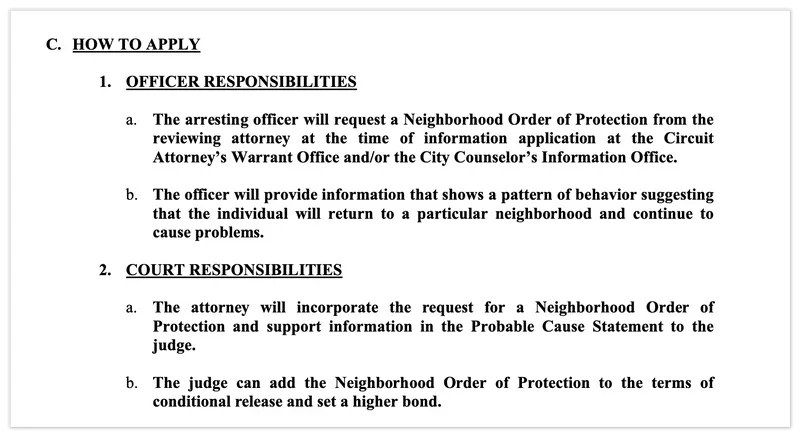
Some cases can linger for years, as police repeatedly seek and enforce neighborhood orders of protection against the same people with little evidence that the orders are effective. In a report in 2017, a St. Louis police officer wrote that he was working for the department’s downtown bike unit and trying to combat a “rise in quality of life violations” downtown. He said a motorist complained about homeless people outside the city’s Dome, where the NFL’s Rams used to play.
One of the men the motorist pointed to was Gary Accardi, who the officer said was a “well-known panhandler,” according to his report. Accardi was holding a cardboard sign that said: “Homeless, Please help. God Bless.”
Four years earlier, in 2013, police had cited Accardi five times for violating a neighborhood order of protection, and he had spent 10 days in jail. As the officer approached, he wrote in his report, Accardi ran away yelling, “I don’t want to go to jail!” The officer wrote that he caught up with Accardi and put him on the ground to get him under control.
Accardi was charged with panhandling, resisting arrest and impeding traffic. Weeks later, Accardi agreed in municipal court to stay out of downtown St. Louis for one year.

Over the next few years, the order against Accardi was repeatedly extended and he was cited for violating it 17 times from July 27 to Oct. 17, 2018; on two occasions during that stretch he was cited twice in the same day.
In April 2019, while St. Louis Cardinals fans packed Busch Stadium downtown for opening day, police officers spotted Accardi outside the stadium and issued him a summons for violating the order.

The next day, Accardi was rifling through a trash can outside the stadium and another officer cited him yet again for the violation.
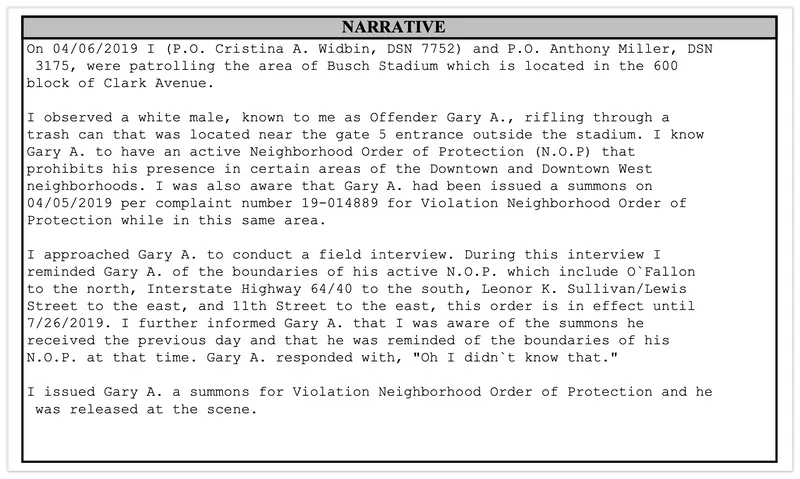
Stephanie Lummus, a lawyer who has represented Accardi in some of his cases, said a judge in 2020 declared him incapacitated and placed him under a guardianship. The guardian, she said, ordered her not to speak on his behalf.
Lummus said she frequently appears in municipal court on behalf of clients with cases on the court’s mental health docket — a special court day designed to match vulnerable people with services that can help them.
“I would sit there and wait for my client,” she said. “And I’d watch these people on the mental health docket sign these neighborhood orders of protection unrepresented, not knowing what the hell was going on. And I was just like, This is not the place for that, you know. These people are on the mental health docket for a reason. Why are you doing this?”
In some St. Louis neighborhoods, private police companies have enforced neighborhood orders of protection. Minutes from a 2018 meeting of a downtown community improvement district indicate that a private policing contractor had pursued neighborhood orders of protection for 25 “persistent offenders.”
Officers working off-duty for The City’s Finest, St. Louis’ biggest private policing company, have enforced neighborhood orders of protection in the Central West End, emails show.
“Neighborhood orders of protection are legal and issued by the courts,” the firm’s owner, Charles “Rob” Betts, said in an email. “If you have an issue with it you should probably discuss such with the court system that issues them. Or better yet, talk to the residents and businesses that are severely affected by aggressive panhandling.”
Whyte’s office, which serves as a substation for The City’s Finest in the Central West End, had a bulletin board where the names of people with neighborhood orders of protection are posted. That way the private officers know whom to look for, emails obtained by ProPublica through a public record request show.
Whyte recalled the case of a woman with chronic drug problems who he said was a persistent panhandler in the Central West End and who had been accused of petty theft. Neighborhood leaders sought to banish her after she created repeated problems.
“We were seeking an order of protection against her because she didn’t live in the neighborhood, didn’t work in the neighborhood,” he said. “She had tallied up a number of incidents and police contacts.”
He said the neighborhood never sought the orders “as an immediate action, it was always used as kind of, ‘Well, we have no other choice.’”
In the fall of 2018, the clock had run out on neighborhood orders of protection against some people who had been banished from the Central West End. Whyte wrote to Richard Sykora, a lawyer for the city who was in charge of pursuing the orders in municipal court.
“Many of our NOP’s have expired and unfortunately many of our problem people have returned to the CWE area,” Whyte wrote, adding, “We would appreciate you looking into obtaining NOP’s on the following subjects.”
Whyte described one person as having “been observed buying narcotics” and another as having stolen a tip jar from a coffee shop. One was “mentally unstable” and “very disruptive at local businesses.” Another had repeatedly violated a previous neighborhood order of protection and, Whyte wrote, “continues to be a persistent panhandler.”
Yet another, Whyte wrote, had been working with an organization that offers behavioral health services but he “has resumed aggressively panhandling.”
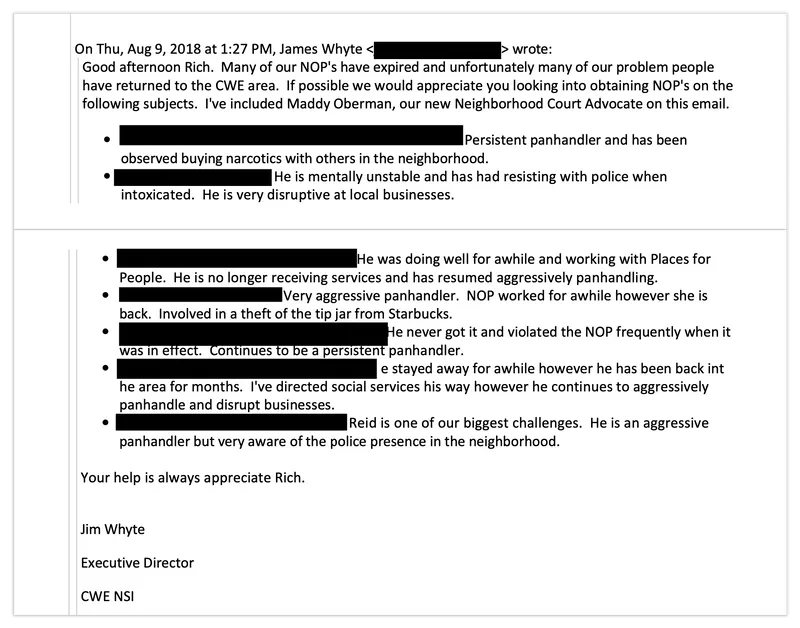
Sykora wrote to Whyte a few days later saying he would seek new neighborhood orders of protection against most of the people Whyte had listed. In one case, Sykora told Whyte, the judge had made only half the neighborhood off-limits so the person could get to his job without breaking the law. Whyte told Sykora that he had checked with the employer and the defendant didn’t really work there. “Could we get the order modified?” he asked.
Sykora did not respond to a request for comment.
Whyte’s requests led to some of those people being banished again. They could be arrested on sight for setting foot in the 1.9-square-mile neighborhood. And some of them were.
Whyte said the neighborhood has sought orders for people that were “running amok in the Central West End neighborhood. They wouldn’t heed any other warnings by the police, they wouldn’t conform, their behavior was antisocial.”
“The reality is they don’t go to other neighborhoods” after being ordered to stay out of the Central West End, he said. “They don’t care about the order of protection.”
Whyte said that since in-person court hearings have stopped, the neighborhood had hired a homeless outreach coordinator to try to address vagrancy in the neighborhood.
One person the neighborhood has banished was Lorse Weatherspoon, a homeless man with a history of petty crimes. He was arrested in the Central West End in 2018 on suspicion of trespassing and burglary after a private policing company posted a $250 reward for his arrest. It isn’t clear what happened with those charges, but the city charged him with five violations of his ban from entering the neighborhood.
“Lorse Weatherspoon was responsible for a crime a night,” said Jim Dwyer, chairman of one of the Central West End business districts that hires private police.
Whyte said residents would send him surveillance video of prowlers, “And I’m like, ‘Oh, that’s Lorse Weatherspoon trying to see if he can get a bike out of your garage or steal your lawn mower.’”
Neil Barron, Weatherspoon’s lawyer, said the order was a “blatantly unconstitutional violation of a person’s right to freely travel.”
“Think about all the money used on this,” he added. “Does it solve the problem? Does it make the community safer? Does it help Lorse Weatherspoon rehabilitate himself? No, it doesn’t.”
